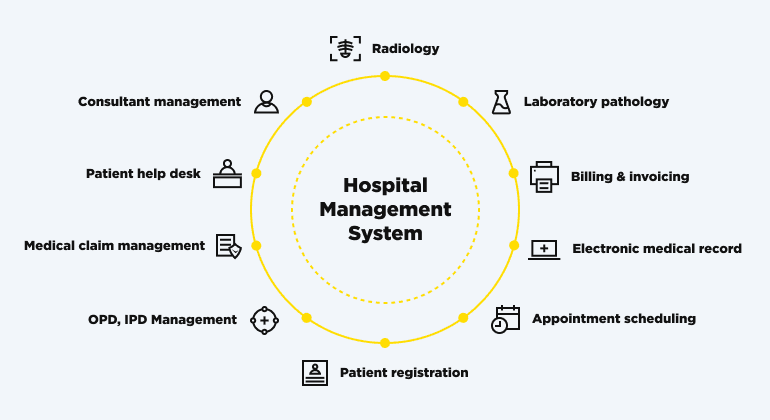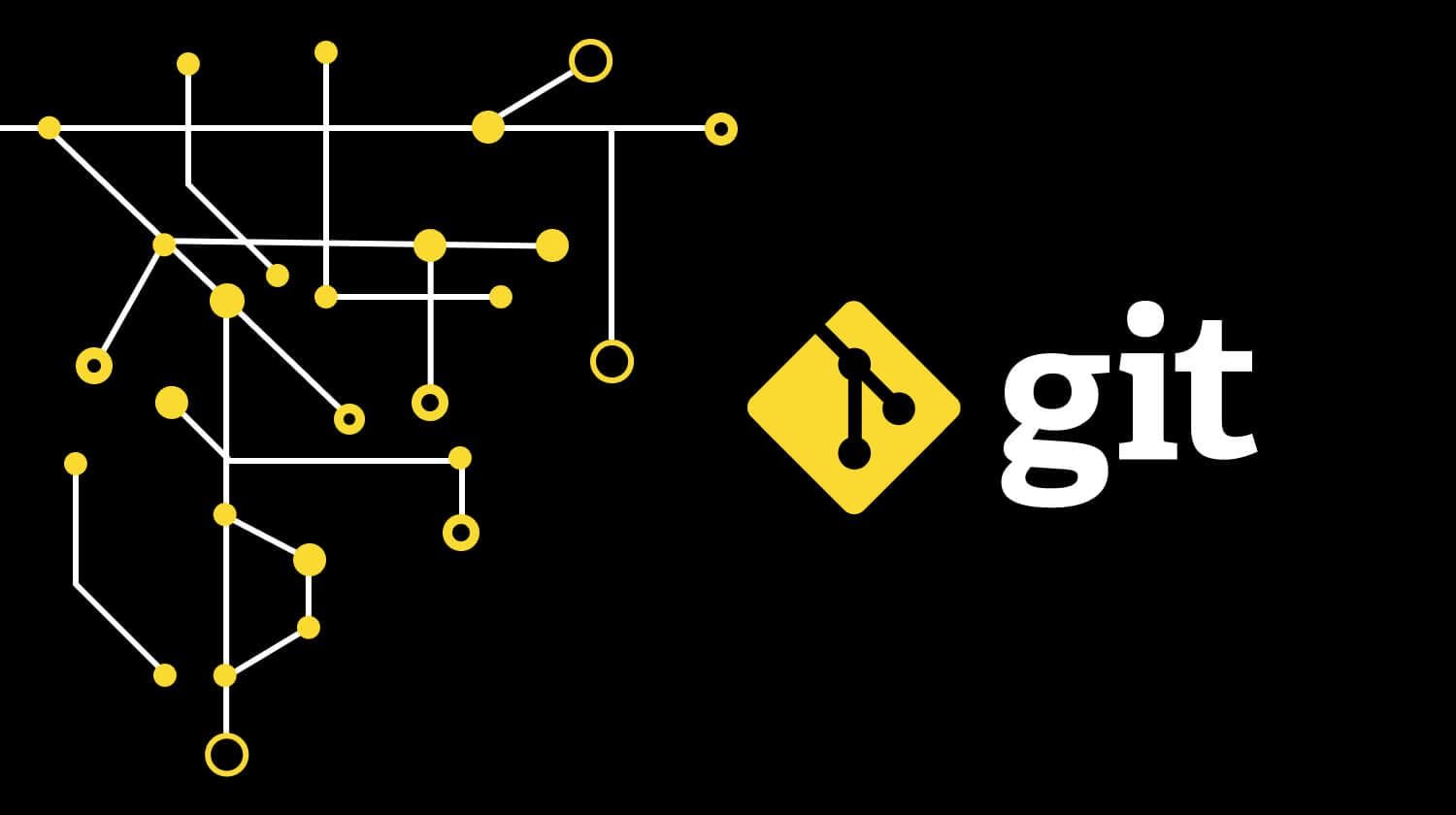Building a powerful application takes some time, effort, and resources. However, keeping this application or software running smoothly can sometimes be even more challenging. That is when software performance optimization and thoughtful architectural design come into play. It is one of the most critical aspects of building successful software solutions. Imagine yourself being a user – are you ready to use a slow or laggy app? We bet you aren’t! Most people just quickly abandon such products. Your end users expect to get responsiveness, speed, and their expectations met.

According to Forrester's predictions report, about 80% of IT leaders reported to have increasing software costs in 2024. The projections expect about 14% rise in 2025. Considering such predictions, performance optimization is becoming even more important as it can minimize expenses and boost your return on investment. In this article, we will discover the essential aspects of performance optimization in software development, how to identify potential bottlenecks and the best practices you can follow to ensure your software performs at its best. Ready? Let’s go!
How Do You Define Performance Optimization?
So, what is performance optimization? In simple terms, it is about ensuring that your software runs efficiently. What does “efficient” mean in this context? It implies providing the best possible experience for your end-users while taking minimal resource usage. Sounds fair, right? When you opt for software optimization, it is crucial to focus on the key areas:
- speed,
- responsiveness,
- scalability,
- and resource utilization.
It is important to mention that it doesn’t matter whether you're developing a web application, mobile app, or enterprise software, optimizing your software’s performance should always be a top priority.
We can’t help noting that it’s not just about making things faster for the sake of it. It’s about finding the right balance between functionality, efficiency, and smart architectural decisions.
What Performance Metrics Should Be Considered?
We’ve already mentioned briefly what areas you should focus on when optimizing performance. However, you need to understand the metrics that define software performance. Once you get it right, it’s easier to figure out how well your software is performing and which areas need improvement. Let’s explore the key performance metrics.
Code-level optimization
The code optimization is a common type of service we provide to our clients. Mostly, it is about making efficient algorithms, reducing the amount of redundant (or old-fashioned) code, and simplifying complex functions (all perfect things are simple). The task is to write clean, efficient code on the way to software performance optimization.
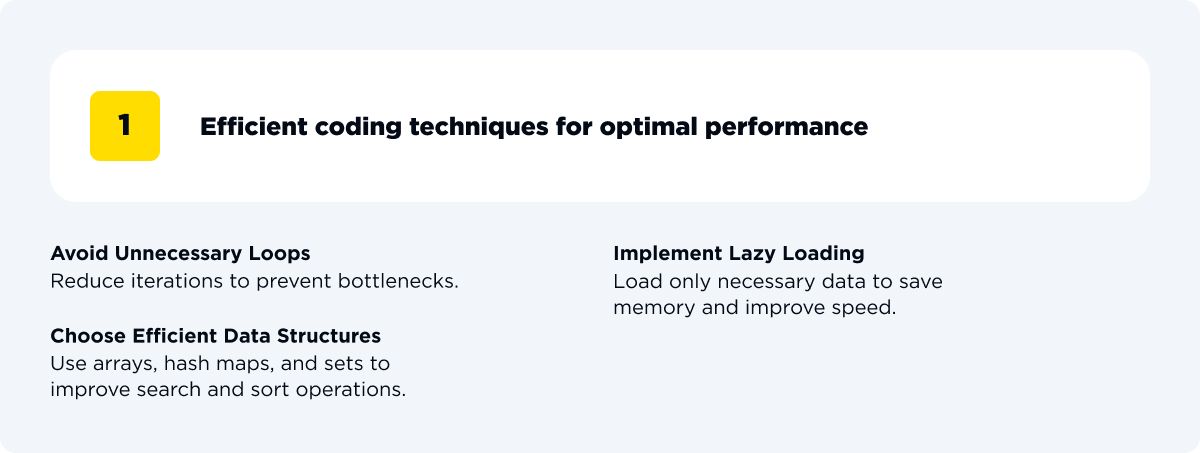
We would also like to identify a few types of code-level optimization.
#1 Avoiding unnecessary loops
Such loops are usually considered performance bottlenecks. When it’s possible to reduce the number of iterations and make your loops more efficient, you can expect a considerable performance gain in software.
#2 Efficient data structures
Sometimes it might seem easy, but it’s a crucial step in performance optimization. Choosing the right data structures (like arrays, sets, and hash maps) can make a huge difference in performance. In particular, when it comes to searching, sorting, or modifying data.
#3 Lazy loading
Why does a product need to load everything and exhaust the storage, consumption and speed? It is needed to load only the necessary data at a particular time instead of everything all at once. This way, you can reduce memory consumption and improve app performance.
Database optimization
Another critical source of performance issues comes down to the database. Software speed can be significantly affected when slow database queries occur. And, you might know, the amount of data is only growing with time. So, are there any ways to database optimization? Of course! Let’s discover.
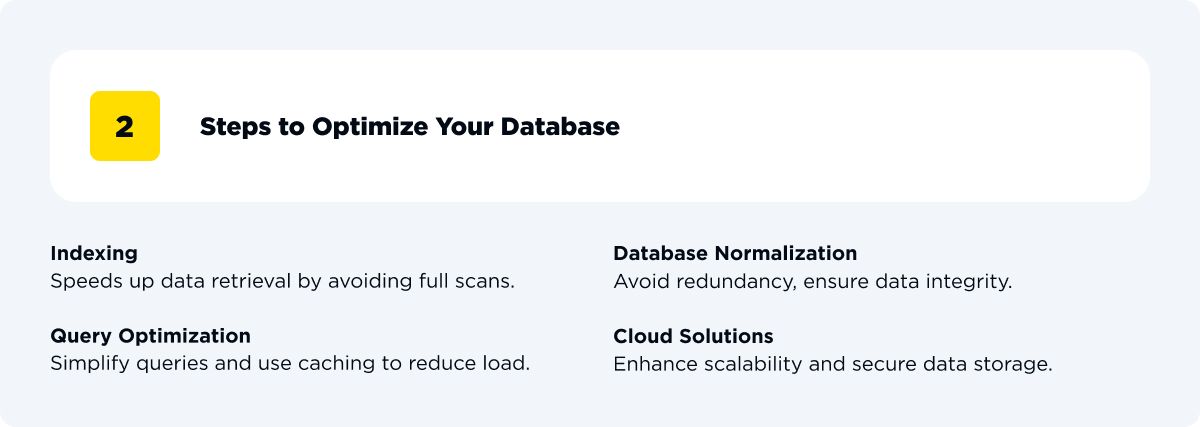
#1 Indexing
When you apply proper indexing, it ensures that the database can quickly retrieve data without scanning the entire dataset. This way, it doesn’t put any extra pressure on the whole system.
#2 Query optimization
It is crucial to avoid using overly complex queries that can slow down performance. That’s what our team at OTAKOYI always conducts – we break them into simpler queries or use caching techniques to reduce the load.
#3 Database normalization and cloud solutions
Another important way is to avoid redundancy and improve data integrity by normalizing your database scheme. One of the best solutions for database normalization is adopting cloud solutions (or hybrid ones) also to secure all the data.
Front-end optimization
It is no secret how important the front end is. Its performance is basically a part of the user experience. When there are some issues with frontend performance, customers face slow-loading pages or laggy interfaces. What are the consequences, you might ask? People are likely just to leave this product and switch to their competitor. Let’s discover what are the ways to optimize frontend performance.
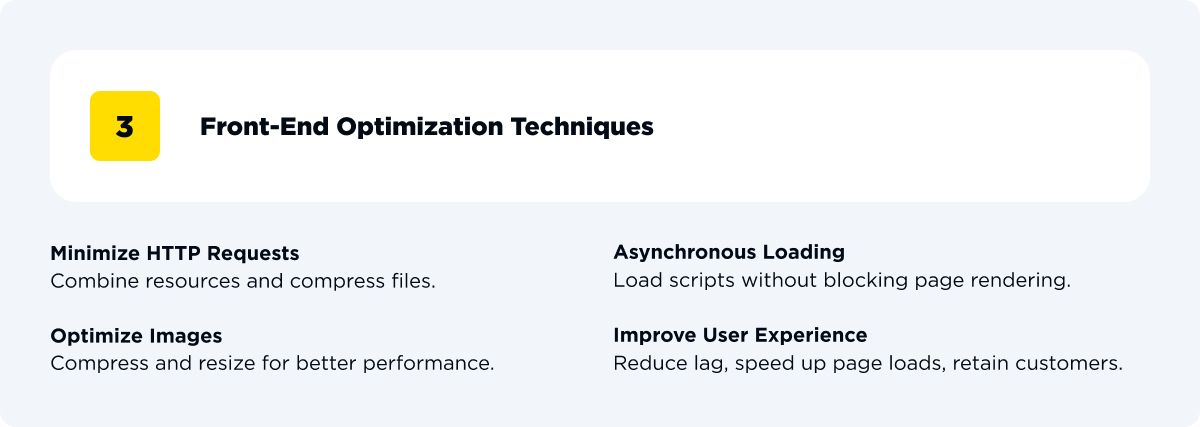
#1 Minimize HTTP requests
In order to follow this optimization approach, you should reduce the amount of resource consumption of your web page loads. IN involves images, scripts, videos, stylesheets, etc. It is helpful to combine these resources into a single file or use image compression.
#2 Optimizing images
It is one of the very common methods of streamlining frontend performance – compressing and resizing images. This way it ensures they’re not taking up unnecessary bandwidth.
#3 Asynchronous loading
One more trick to handle performance is to load JavaScript and CSS asynchronously. This approach is quite tricky yet functional – other parts of the page can load and render while the scripts are still being processed.
Backend and network optimization
Any backend developer will tell you that backend optimization is about reducing server load. What is the result? It improves response times and ensures efficient data handling. It’s like the perfect scenario for any software. If you’re interested in some best practices, we’re mentioning some below.
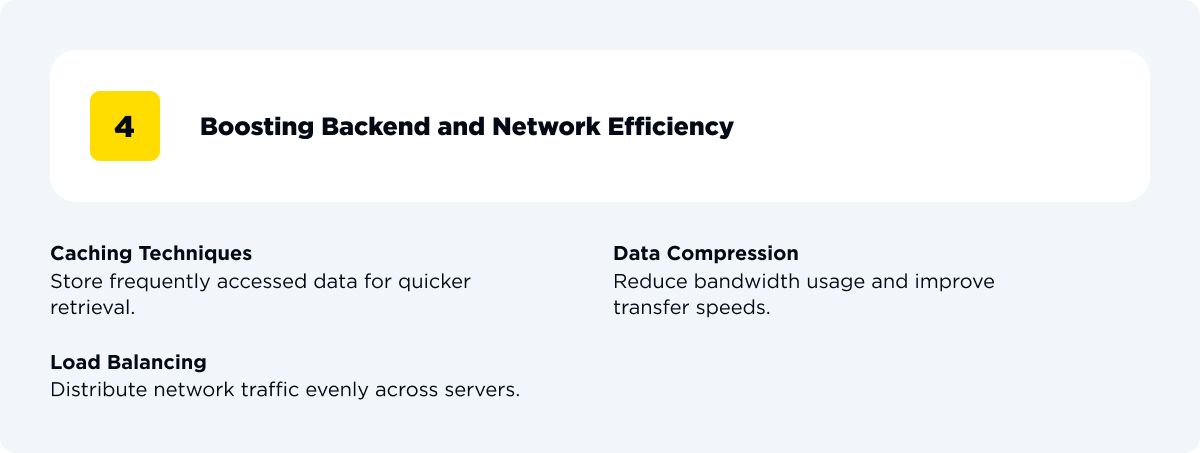
#1 Caching
This method gives you a chance to store the data that is frequently accessed. This way, your system doesn’t need to fetch it from the database or recompute it every time it’s requested.
#2 Load balancing
The best practices show that you need to distribute incoming network traffic evenly across multiple servers for load balancing. As a result, you can easily avoid overloading a single server.
#3 Compression
How do you reduce bandwidth usage? Old but efficient way – compress the data being sent over the network. Such an approach leads to streamlined transfer speeds due to better network performance.
Testing and monitoring
Of course, all previous performance metrics to consider are crucial. Nevertheless, you should remember that optimizing software performance isn’t a one-time task. As with any perfection, it’s an ongoing process that involves regular testing and continuous monitoring. That should be done to keep your application performing well as it evolves.
There are testing tools like load testing and performance testing that can simulate different usage scenarios. Applying them, you can identify potential performance issues before they occur or, not to mention, affect users.
Apart from testing tools, there are performance monitoring tools like New Relic or Datadog. It is a great way to use automation tools to track your software’s performance in real time. If anything is alerting, it informs you immediately. You, consequently, can make only data-driven decisions about where to focus your optimization efforts.
Discovering Potential Performance Bottlenecks
You might use all the previously mentioned metrics, but you must remember an important fact – sometimes, performance issues aren’t obvious. Will we surprise you if we say that software developers need to dig deeper sometimes when looking for the root cause of the problem? However, there is a solution – you can use a few techniques to identify performance bottlenecks.
Profiling
Profiling tools are just great and allow you to analyze your software’s performance in real time. They help you identify which functions or inefficient code blocks are consuming the most resources. Sounds great, right? Profilers break down your code’s execution time and memory usage, so you can spot areas that need performance optimization in software development.
Code reviews
This technique is the most frequently applied. Keep in mind code reviews aren’t just for catching bugs or ensuring efficient coding practice. Mostly, these reviews are made for spotting performance issues. As soon as QA specialists have reviewed the code with an eye for performance, they can often identify inefficient coding practices that might slow down your software or cause any issues.
Log analysis
No wonder we’re often told that we should learn from history. Log analysis is crucial as well. It contains valuable information about your application’s behavior. What happens when you analyze logs? You can easily identify performance bottlenecks or even track down bugs that cause performance issues. Slow database queries, for example, often show up in logs as long response times.
Benchmarking
One more technique is benchmarking. This comparative analysis is about taking the performance of your application and comparing it against industry standards or previous versions. Even though it can take time, running such benchmarks can help you measure improvements over time or figure out where your software is failing.

Optimize your software performance
GET STARTEDWhat Are The Best Practices And Use Cases for Performance Optimization?
Just knowing the ways is not enough. The secret to keeping your software fast and efficient is following some of the best practices for performance optimization. Let us provide you with them and some real use cases.
#1 Write efficient code from the start to avoid any performance issues later.
A popular use case is GitHub. In 2021, it improved the performance of its web platform by optimizing its API requests. It led to reducing the payload size and faster response times. most importantly – a seamless experience.
#2 Test early and often as it is easier and cheaper to fix any issues at an early stage.
For example, Airbnb conducted extensive A/B testing in 2020. The performance goals included improving website performance (load time, dynamic elements, etc.) They did their best to ensure that the website could perform smoothly even under increased user traffic.
#3 Monitor regularly to catch and track everything early.
The example we’ll give is Shopify. In 2020, they implemented advanced monitoring tools to track both server and user-side performance. The result is minimal downtime and optimal transaction speed during peak shopping events.
#4 Optimize for scalability and mobile users to make sure your app grows with your business.
For example, Spotify moved to a microservice architecture in 2020 to be ready for scaling. Another example is Instagram, which, also in 2020, made several optimizations to improve mobile app performance (just in time for the lockdown period, right, when everyone didn’t leave their phones).
#5 Use AI for predictive tuning to identify performance bottlenecks before they happen.
A popular example is Google Cloud which introduced an AI-powered tool for performance optimization in 2022. It applied machine learning to predict any spikes and adjust available resources to deliver seamless user experiences.
#6 Optimize database queries to speed up performance.
For instance, in 2021, Netflix optimized its backend by implementing GraphQL for more efficient data retrieval. As a result, they can avoid redundant database queries and reduce load times by fetching only the necessary data.
#7 Use Content delivery networks (CDNs) to reduce latency and improve performance.
We’ll give another Netflix example. Also, in 2021, they invested in AWS CloudFront, a CDN solution, to optimize video streaming across the globe. Subsequently, they made consistent user experiences and high-quality streaming without buffering.
#8 Profile and optimize resource-heavy processes to avoid any bottlenecks.
In 2022, for instance, Dropbox optimized its file synchronization process. They moved away from a single-threaded approach to parallel processing. The outcomes are streamlined overall sync speeds and reduced the time users had to wait for large files to be uploaded or downloaded.
When you follow these practices in your development process, you can optimize software performance. Make sure your product is fast, scalable, and efficient, meets user expectations, and performs well under pressure.
Performance Optimization With OTAKOYI: How Can We Help?
The benefits of performance optimization are undeniable. The same goes for benefits when partnering up with OTAKOYI for such a service. What do we bring for you?
#1 Custom software development for your unique business needs
#2 State-of-the-art UX/UI design solutions to boost user satisfaction
#3 Top-notch and efficient software optimization services for scalable products
#4 Modern technology expertise to stay ahead of market trends
#5 Thorough and exceptional performance optimization for better speed and reliability
#6 Competitive edge to win over the competition
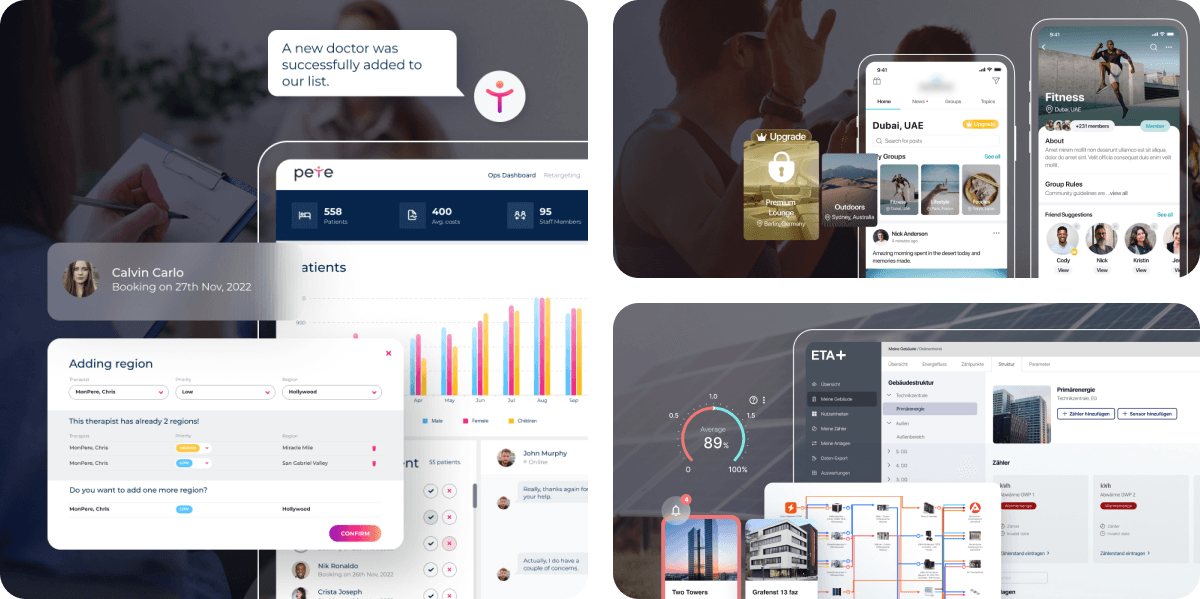
OTAKOYI software optimization services ensure that your software applications run efficiently. We focus on all key areas – improving performance, scalability, and maintainability. Our goal is to help businesses achieve optimal performance, the best functionality, and cost-effectiveness. We’ve already leveraged our deep understanding of modern technologies by helping our clients to always stay ahead in the ever-evolving market.
#1 Healthcare Operations Management System for the Physiotherapy Organization
After a thorough performance analysis and planning, we’ve made an effective strategy – platform redesign, added new features, and involved CMS.
#2 NetZero Platform Re-Engineering: Upgrading from AngularJS to Angular
This project involved the transition from AngularJS to Angular 17 as well as shifting from monolith architecture to microservices. The crucial parts include platform and database optimization.
#3 Social Mobile Application Re-engineering and Cloud Migration
The performance requirement for this project’s optimization was for better app scalability and global accessibility. We’ve also migrated from monolithic to cloud-based architecture. This way, the client has received a cost-efficient serverless infrastructure of the product.
As you can see, our specialized expertise in performance optimization in software development can guide you through every step of the process and help improve the speed, reliability, and scalability of your software.
Wrapping Up: Performance Optimization As A Must
Last but not least, performance optimization is an ongoing journey. Please consider it as a maintenance and continuous improvement of your product. The real success formula of efficient software performance optimization is partnering with a dedicated team of professionals, adopting best practices, and understanding the key areas that may influence performance.
Nowadays, optimizing your code, database operation, frontend, or backend is a must. However, this necessity helps you build fast, scalable, and user-friendly solutions to make your users happy and your business grow!


